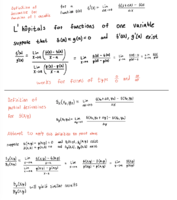I asked this question to my professor but couldn't give me a definitive answer.
My textbook says that if you were to take the Lim (x,y) --> (a,b) of f(x,y) there would be an infinite amount of paths it could take to approach (a,b). It then gives an example of some function where they take the Lim (x,y) --> (0,0) of f(x,y) . First they let x = 0 and take the limit as y approaches 0 (tracing the y axis). Then they do the same thing for x and take the limit so that is gets to the origin by tracing the x axis.
They only showed two ways to get to the origin for this function of two variables and I cant think of any other way to get to the origin. If they held x at some constant other than zero and took the limit as y approached zero, it would never hit the origin. Y may get to zero but x is still constant, so how are there an infinite amount of ways to get there?
When your dealing with a function of one variable it is bounded by one path.
If you were to try and apply L'Hopital's rule to a rational function of more than one variable, and took the partial derivative of top and bottom you would get four combinations fx(x,y)/fx(x,y) , fy(x,y)/fx(x,y) , fy(x,y)/fy(x,y) , fx(x,y)/fy(x,y) . Assuming you only had to apply L'Hopital's rule once and the limit of all of these 4 combinations approached the same L, would that not work? It may be a lot of work to take the limit 4 times, especially if you had to apply it twice and do it more.
I realize its a lot to unpack but its got me curious as to why that wouldn't work. Let me know where/if my logic is flawed
My textbook says that if you were to take the Lim (x,y) --> (a,b) of f(x,y) there would be an infinite amount of paths it could take to approach (a,b). It then gives an example of some function where they take the Lim (x,y) --> (0,0) of f(x,y) . First they let x = 0 and take the limit as y approaches 0 (tracing the y axis). Then they do the same thing for x and take the limit so that is gets to the origin by tracing the x axis.
They only showed two ways to get to the origin for this function of two variables and I cant think of any other way to get to the origin. If they held x at some constant other than zero and took the limit as y approached zero, it would never hit the origin. Y may get to zero but x is still constant, so how are there an infinite amount of ways to get there?
When your dealing with a function of one variable it is bounded by one path.
If you were to try and apply L'Hopital's rule to a rational function of more than one variable, and took the partial derivative of top and bottom you would get four combinations fx(x,y)/fx(x,y) , fy(x,y)/fx(x,y) , fy(x,y)/fy(x,y) , fx(x,y)/fy(x,y) . Assuming you only had to apply L'Hopital's rule once and the limit of all of these 4 combinations approached the same L, would that not work? It may be a lot of work to take the limit 4 times, especially if you had to apply it twice and do it more.
I realize its a lot to unpack but its got me curious as to why that wouldn't work. Let me know where/if my logic is flawed

